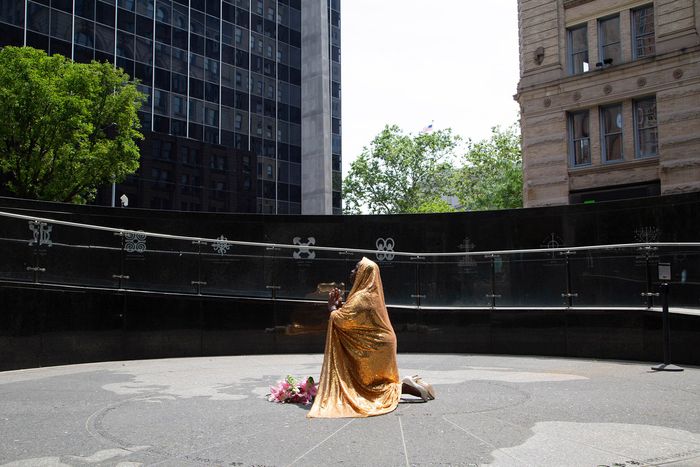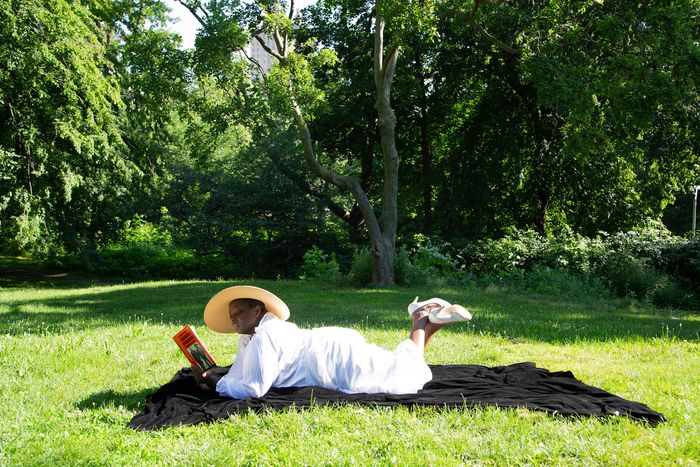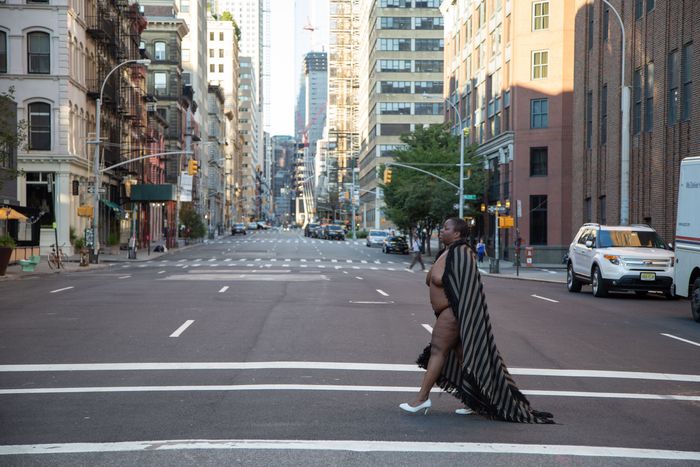
If one of New York City’s enduring charms is its ability to reinvent itself, then the ways in which artist Nona Faustine’s photographs uncover the ugly history conveniently concealed by those reinventions is what makes her work so deftly striking. Faustine poses, often nude or partially clothed, for self-portraits at sites around the city — an MTA bus depot in Harlem, Tweed Courthouse in Manhattan’s Civic Center, the Lefferts Historic House in Brooklyn’s Prospect Park — that have ties to New York’s history of slavery. The photographs, over 40 of which will be on display in Faustine’s first solo exhibition at the Brooklyn Museum, “White Shoes,” on view March 8 through July 7, create portals to sites of significant trauma and resilience, revealing truths that the city has largely under-acknowledged and moved on from.
“I’m bringing some accountability, some knowledge, some visibility to these people who are my ancestors and have built this country and have received nothing,” the 47-year-old artist tells me from her Brooklyn apartment over a video call in mid-February. During our chat, there’s an ebb and flow between enthusiasm and solemnity in discussing her work and the history she’s in constant conversation with. I first came across Faustine’s photographs over a decade ago in an art-history class. Her placement of herself, taking up poses both theatrical and resolutely mundane, in environments that otherwise wouldn’t make you look up from your phone, feels almost like coming across a curbside reliquary. Her body, always solitary in the frame, serves as a reimagination of statues erected to celebrate racist and colonialist ideologies and men. Instead of honoring battles won, her soft and naked body invites the harrowing reminder of people and cultures and legacies lost.
Faustine tells me about a day that “captivated” her “as a born-and-bred New Yorker and a young artist.” It was 1991, when she was walking home through New York’s Civic Center and passed by a large excavation pit at Duane Street and Broadway. A security guard told her that bodies had been found during the construction of a new federal building. Faustine had happened along the beginning of the recovery of the city’s earliest known cemetery, an African burial ground from the 17th century that had been the final resting spot of an estimated 20,000 mostly enslaved and some free Africans and African Americans. She had been taught in school growing up that New York City, like many northern cities and states, wasn’t really complicit in the country’s slave trade, and that slavery was more of a southern infliction. But, she later learned, the city was home to the second-highest population of slave owners in the country by 1730, behind only Charleston, South Carolina. That day “split that notion wide open” for Faustine.
Faustine grew up admiring her father’s and uncle’s photography practices, the latter of whom gifted her her first camera at 4 years old. But after attending the School of Visual Arts for undergrad, she mostly abandoned her artistic pursuits until she became pregnant with her daughter in 2008. “When I was pregnant with that baby, I all of a sudden picked up the camera seriously,” she says. She started taking self-portraits and then photos of her daughter and her mother all living together at the time. A collection of these photographs became “Mitochondria,” a show that captures the intimacy of a family album, documenting the joys of the domestic mundane in a Black matriarchal household.
In one of the photographs in the exhibition, a self-portrait at Tweed Courthouse titled They Tagged the Land with Trophies and Institutions from Their Rapes and Conquests, she pushes her body up against an exterior marble column, not unlike Sisyphus muscling the boulder up in Tartarus. In RESIST!, Faustine stands at the intersection of Maiden Lane and William Street in the Financial District, wearing a long, white peasant skirt and sensible white pumps, a wide-brimmed black hat, and no top. She triumphantly raises a pistol, one similar to what Harriet Tubman once carried with her, to the sky. In another, Faustine leisurely sprawls out on her belly, reading a book in a white sundress, with white shoes on her crossed feet, at the site where Seneca Village — New York’s largest community of free African American property owners — once stood. We now know the area as Central Park, which the city forced these residents out of to construct. As seen in the Seneca Village portrait, not every photograph feels solemn. The outfits, the poses, and the dappled, glorious light are sometimes quite lovely. But in each photograph, you feel the pull between the history of Black Americans’ lives cruelly dictated by our country’s genocidal racism and the varied current-day experiences of at least one Black woman’s relationship to that history. Faustine’s photographs, though flat on the page, extend a portal between these two planes.
“As an African American and a descendant of enslaved and Indigenous people, there’s something intuitive and instinctual that happens when I go to these sites,” Faustine explains. Sometimes, she goes with an outfit and pose in mind, though more often it’s a more improvised process. The final photographs from the Lefferts House were a result of an unsatisfactory first attempt, followed by a return to the site with a handmade belt of baby shoes tied around her waist to achieve the tone and character she wanted to channel. She recounts a funny story of changing her clothes and removing her top in an outdoor stairwell, only to look up and see a security camera for (what she would soon learn was) the Federal Reserve Bank of Manhattan pointing down at her.
Even though Faustine takes these photographs during less-trafficked times in the city — holidays, early mornings, weekends — there’s no denying that a Black woman in various states of undress, posing at government and city-owned buildings, occasionally brandishing a prop pistol or frying pan, has to act with precision. “You have to be confident in those moments,” she says, “otherwise the camera will pick it up. I feel very powerful, I feel very natural. I’m just myself. I’m the most myself in that moment.” The camera, indeed, does pick that up. Understanding the speed at which the world is moving around her only sharpens the exactitude of her commanding solitude against these cityscapes.
Not only do deserted streets present less distractions, and simultaneously less threats, but the alternative would redefine the impact of her work. Faustine tells me that fellow photographer Renee Cox once chided her, saying, “What would be really good is if you [took these photos] while all those workers were down there.” Faustine laughs recalling the exchange but pivots to a more serious contemplation of her process. “While that may be true, it takes on a different context,” she says. “When you have a lot of people in the frame,” or around you, she explains, “then it can become a spectacle, which this is not. It’s kind of a private thing where I’m almost, like, communing with spirits.”
If Faustine’s work was just as straightforward as photographing oneself at sites of historic trauma, they’d be noteworthy but perhaps not as striking as what she is able to capture. She jokingly describes herself in the photos as “almost being like a kid. You know, how little kids are half-dressed outside playing, they’re in the backyard with the hose, babies running around in Pampers.” That’s exactly what her outfits bring to mind, and perhaps what makes them so enchanting to take in. Not only is Faustine giving ample space for her imagination to run wild, but she’s giving us permission to do the same. By infusing that sense of play into these sites that carry so much trauma with them, she is constructing a reinvention of her own, one that doesn’t hide but instead incorporates its own history.
More From This Series
- Women Artists to Watch at Frieze Los Angeles
- Artist Eny Lee Parker Just Wants to Play Around
- A Soft New World









